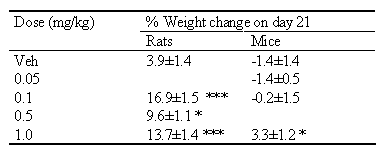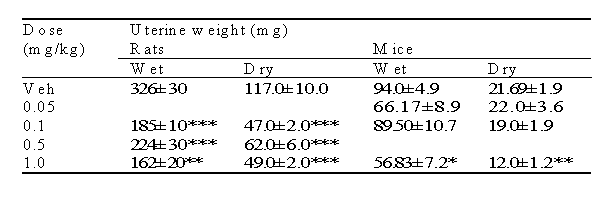| pA2
online © Copyright 2003 The British Pharmacological Society |
057P
University
of Manchester Autumn Meeting September 2003 |
|
The
effect of haloperidol on reproductive function and weight gain:
a comparison between rats and mice |
Print Abstract Search PubMed
for: |
Weight gain and sexual dysfunction are recognised side effects of antipsychotics, but little is known about the underlying mechanisms responsible (Allison et al., 1999; Cutler, 2003). A suitable animal model has yet to be developed which would contribute considerably to the elucidation of such mechanisms. The aim of the present study was to compare the effects of sub-chronic treatment with the classical antipsychotic, haloperidol on body weight and reproductive function in female rats and mice. Subjects were 24 female hooded Lister rats (200±20g) and 24 female balb-c mice (22±2g) group housed under standard laboratory conditions with free access to food and water. Haloperidol (0.05-1mg. kg-1 i.p.) or vehicle was administered once per day for 21 days and body weight, food and water intake measured, in addition to histological examination of vaginal lavage to determine the stage of the oestrous cycle. On day 21 animals were sacrificed and the wet and dry uterine weights recorded. Statistical comparisons were made using 2 way and 1 way ANOVA with post hoc Dunnett's t-test. Data are expressed as mean ± SEM (n=6 per group and per cage). Oestrous cycle data were analysed using Fisher's exact test. Haloperidol had no effect on food or water intake in either rats or mice. Haloperidol significantly disrupted the oestrous cycle, (6 out of 6 animals stopped cycling compared with 1 out of 6 in the vehicle groups) in rats (0.5 and 1.0 mg. kg-1, p<0.001) and mice (1.0 mg. kg-1, p<0.001).
Table 1. Effect of haloperidol on percentage weight change from day 0. * p<0.05, *** p<0.001 significantly different to vehicle group at that time point.

Table 2. Effect of haloperidol on uterine weight. * p<0.05, **p<0.01, ***p<0.001 significantly different to vehicle group at that time point.

These data suggest that haloperidol can disrupt reproductive function in both rats and mice, but the weight changes seen differ between the two species.
Allison,
D.B. et al (1999) Am. J. Psychiatry 156, 1686-96.
Cutler, A.J.(2003) Psychoneuroendocrinology 28 Supp1, 69-82.